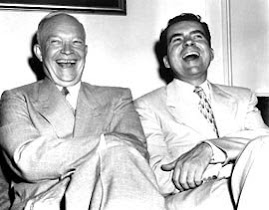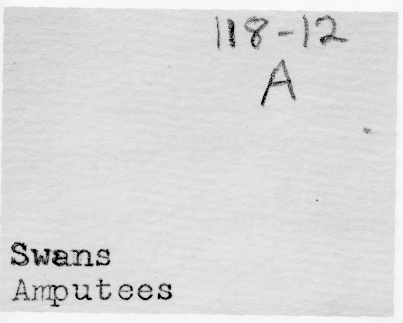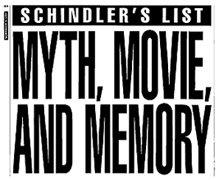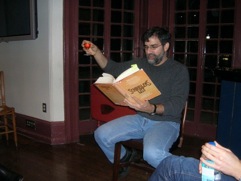 In the early 90s I taught my class on the literature and culture of the 1950s. The course was about consensus and these young brilliant doubters decided that the form the seminar should take should be dissensus--in itself a resistance to the material. They went hog wild and I let them do so. These were heady early days of the web and we put a summary of the (non)final exam essays on a web page here.
In the early 90s I taught my class on the literature and culture of the 1950s. The course was about consensus and these young brilliant doubters decided that the form the seminar should take should be dissensus--in itself a resistance to the material. They went hog wild and I let them do so. These were heady early days of the web and we put a summary of the (non)final exam essays on a web page here.The photo at right (created by the students in a then-new program called Photoshop) morphs me onto a singing/dancing/chanting it's-no-longer-the-1950s Allen Ginsberg.
At the end of the course, one of the students wrote: "We thrive upon cognitive dissonance; we never shrink from conflict, understanding that 'the disagreements themselves can be the point of connection' (to quote Gerald Graff's book on teaching the conflicts). There have been times that we have yearned for consensus, for closure, but we all agree that the most engaging, the most thought-provoking, sessions have been those left unresolved, both sides of the room ruddy-faced and hot under the collar as we collect our materials for our next class."
"I am indeed still muddling, sifting, figuring, reconfiguring, and getting a more firm grip on what I think," wrote Michelle, "but that effort no longer constitutes my position on anything. Even those 'who claim to be so straight as to the way they view the world,' of whom I had been suspect but also admired, are also still in a process of thinking and rethinking."
"This is what happens," writes Ellona, "to the undergraduate who is rejected by intellectual community: when students are assuaged into believing that they take nothing relevant from a course other than a letter on their transcript, they build an ideology of test scores and essay grades, and grow to love being judged solely by others for the intellectual content of their thought, rather than testing the limits of their own intellects against another person."
"A university," Christy writes, "should be a safe place for students to experiment with ideas and to challenge our perceptions of the world...." Alas, she writes, in the current climate the student "quickly learns to keep his mouth shut about an issue until the professor has told him what to think about it. THIS IS NOT AN EDUCATION; IT IS CLASSICAL CONDITIONING AT ITS BEST." So "What needs to happen for such an environment to occur? Student-faculty interaction is undoubtedly a place to start. Students need to be able to discuss their ideas and beliefs with people who are more experienced at questioning such issues. Students need to learn to defend their beliefs against someone who knows more about the subject; this will force us to think critically about the issues with which we are working, and ultimately will teach us how to construct and deconstruct an argument. We will begin to understand the world around us in a very real way, and this understanding will provide us with ways to interact with the world."
The above-mentioned Ellona wrote up an "Undergraduate's Bill of Rights and Responsibilities." These included:
You have the right to conduct undergraduate research, and have its intellectual content taken seriously.
You have the right to prioritize teaching in the tenure process. You have a right to protest that lack. You have a right to expect that your concerns matter.
You have the right to organize class dinners and parties, and to invite the professor to attend without feeling you've overstepped the boundaries of propriety by mingling social and academic pursuits.
Under "Responsibilities":
This contract is in danger of being dissolved by the "University" at all times. You have not just a right, but a responsibility, to see that the academic community includes you at all times, and a responsibility to fight like hell when a Provost or Undergraduate Chair or tenured professor defines that community without you in it.
Finally she added: "In my ideal academic community, everyone would know this by heart, would recite it word for word and then follow it up with a Shakespeare sonnet."
[] See this comment on the above.






 "I teach horizontally, meaning that while I might begin with a fixed idea of what I'm going to teach that day, I let it drift rhizomatically way off topic, often pulling it back when it gets too far. I rely on non-fixed materials to teach this way; the whole world is at my fingertips. Should I go off on a tangent about John and Rauschenberg and their love relationship as expressed in Rauschenberg's bed, an image of that bed is always a click away. From there, we can head anywhere into the non-fixed universe, be it film, text or sound. And of course, that always takes us elsewhere. As Cage says, 'We are getting nowhere fast.'"
"I teach horizontally, meaning that while I might begin with a fixed idea of what I'm going to teach that day, I let it drift rhizomatically way off topic, often pulling it back when it gets too far. I rely on non-fixed materials to teach this way; the whole world is at my fingertips. Should I go off on a tangent about John and Rauschenberg and their love relationship as expressed in Rauschenberg's bed, an image of that bed is always a click away. From there, we can head anywhere into the non-fixed universe, be it film, text or sound. And of course, that always takes us elsewhere. As Cage says, 'We are getting nowhere fast.'" 

 that anyone has yet got the imaginative measure of that terrifying day six years ago. Certainly our Tolstoy has not crawled out of the rubble. The closest we have, Don DeLillo, succeeded as an essayist-journalist ("In the Ruins of the Future: Reflections on Terror and Loss in the Shadow of September,” Harper’s, December 2001) but, to my mind, failed as a novelist ("Falling Man"). One reason, perhaps, is that the remembered emotion was instantly buried under a pile of cultural junk.' - Tod Gitlin in his review of Susan Faludi's The Terror Dream (written for
that anyone has yet got the imaginative measure of that terrifying day six years ago. Certainly our Tolstoy has not crawled out of the rubble. The closest we have, Don DeLillo, succeeded as an essayist-journalist ("In the Ruins of the Future: Reflections on Terror and Loss in the Shadow of September,” Harper’s, December 2001) but, to my mind, failed as a novelist ("Falling Man"). One reason, perhaps, is that the remembered emotion was instantly buried under a pile of cultural junk.' - Tod Gitlin in his review of Susan Faludi's The Terror Dream (written for 






























